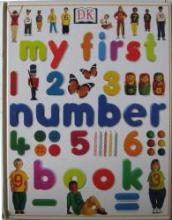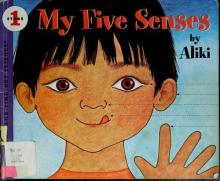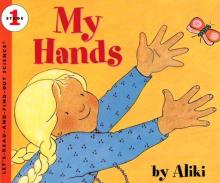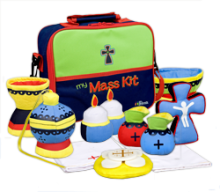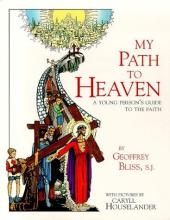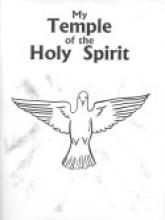No name
My First Missal
My First Number Book
My Five Senses
Aliki, in her classic - simple and charming - style, explains each of the five senses for preschoolers. Text and pictures explain what each of the senses is used for - "When I drink my milk and eat my food, I use my sense of taste. I am tasting." My children ask for this book over and over.
Copyrights 1962/1989. Many later printings / editions.
My Hands
This is a nicely illustrated book for very young children on everything having to do with hands. The very simple text covers the names of the fingers (index, middle, etc.), the sense of touch, right or left-handed, the importance of thumbs and how different hands can be ("Daddy's hands are different from mine. They are big and rough and bony. Mother's hands are soft...") This is a charming little book for helping children appreciate how wonderfully they are made.
Copyrights 1962/1990
My Heart Lies South
This story is delightful for its own sake, but also gives tidbits of history (Mexican and Spanish), religion, and culture. It is also the sort of book that is useful and delightful for teenage girls to read as they begin to consider their future roles as mothers, wives and influences on their community. (The humorous incidents will probably keep it interesting enough for the guys as well.) There are some references to dating and courtship, the consequences of drinking too much and other subjects which would not be suitable for young children (although they are handled in a reasonable manner). Don't be turned off by the word "seduction" that shows up in the first few pages. It comes up in a fairly harmless context and is not an indication of shocking material to come.
I also found her discussions of parenting interesting because she was raising her children at a time when American doctors advocated bottle feeding and a sort of detached parenting . When she wrote the story, however, the doctors had begun to come around to a healthier and more natural parenting philosophy and the author expresses some of her regrets and frustrations at following the conventional wisdom which really went against her instincts.
Her arguments in favor of the Mexican view of the role of women is quite compelling. The Mexican role is, in many ways, very Catholic. Women are not inferior or subservient (as in the "Leave it to Beaver" American model of the 1950s) nor do they feel the need to fight for "equality" as in the American feminist model of today. The Mexican women have (or perhaps had) a very strong and dominant role within the family which was the center of society. They liked to make their husbands feel manly by allowing them to help them because it made them better husbands and companions. Although the author does not fully embrace every particular of the Mexican customs in this regard, she sees them generally as the women's way of cunningly "allowing" the men to feel superior in order to keep them happy while almost always having the final word.
My Librarian is a Camel
The libraries I grew up with did not even resemble what we have available today... truly. I am not able to go to my weekly visits to the library without being amazed at how fortunate we are. This friendly book will help your children appreciate what some other children in the world go through to be able to borrow a book!
Going beyond that, the book has information and maps on each country discussed and lots of fun photographs!
My Mass Kit
My Path to Heaven
This is one of the nicest educational materials I've come across (and I think that's saying a lot). What this book amounts to is a simplified form of the Spiritual Exercises of Saint Ignatius, designed to be understood by children. This is cleverly done with a very detailed picture for each of the twelve chapters. The child studies the details of the pictures and then the parent or the child reads the text (two or three pages) which explains the details of the pictures. The child is then invited to look at the picture again. The text is read a second time and then a list of ten to twenty yes or no questions are asked to reinforce the text and determine how well the child understood it. This is not just another religion text teaching facts, but a very persuasive text leading children to desire holiness and the greatest good in their lives. The publisher gives permission for parents to photocopy the pictures for their own children to color while studying the text, which might enhance their interest in the pictures and their ability to notice all of the little details. The book is recommended for children ages nine through twelve, although I've heard from a number of homeschoolers (and found the same to be true in my own family) that younger children and adults will benefit from it as well. Particularly nice for Lent/Holy Week or for First Communion Preparation.
Copyrights 1936/1997
My Temple of the Holy Spirit
Subtitled a Catholic Science Hands On Program of the Human Body, this is a program best used with kids in grades 4 to 8. My Temple of the Holy Spirit is a very practical study of seven of the systems of the body from a Catholic and pro-life perspective. It covers various systems of the body, but not the reproductive systems, the integumentary system, or all of the excretory system. It is thoroughly Catholic, with the Faith integrated throughout. It is user-friendly for both parent and child and very nonthreatening, even for those who are frightened of teaching science.
A typical lesson has a list of terms with definitions that will be used later, the material to be learned with the vocabulary words underlined, a page of comprehension questions, a diagram to label, a list of supplementary activities, and "Fun Facts." The supplementary activities range from Bible reading to field trips to experiments to research papers. The wide range of activities make it easy to adapt this program for students of different ages. Patterns and directions for making a life-sized human body outline with cloth organs are in the back of the book. So are several activities covering all the systems studied, which can be used as a final exam if desired. To use this program properly, it is essential to have access to a library or lots of science books.
This is not a full-year study nor one for high school. Bearing those limitations in mind, this Catholic, pro-life, easy-to-use, hands on, multi-level, and inexpensive study on systems of the human body is an excellent choice for science study.
Update April 2024: The text of this book has been combined with Catholic Boys & Girls Health by Dr. Mary Ann Grobbel into Behold and See 4: Human Anatomy and Health, from Catholic Heritage Curricula. The content has been revised into a full-color spiral-bound "work-text" with a more attractive layout, room for students to write their answers, and color illustrations.


